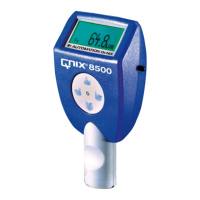Instruction Manual QNix
®
8500
- 20 -
18 Technical Data
Fe probe Measurements on iron and steel surfaces
NFe probe Measurements on non-magnetic metallic surfaces (substrates),
such as aluminium, zinc, copper, brass, certain kind of high-grade steel
Measuring range Refer to special specification
Resolution 0.1 µm 0 to 99.9 µm
(standard 1 µm 100 to 999 µm
setting) 0.01 mm ≥ 1.00 mm
Measuring (Factory calibration in relation to the provided zero reference plates)
accuracy ± (1 µm + 2%*) 0 to 2000 µm
± 3.5%* > 2000 µm
(* of the reading)
With the one-point and two-point calibration the measuring accuracy can
be further improved using the optionally available measuring films.
Minimum Refer to special specifications
Measuring area
Minimum Convex 5 mm
curvature Concave 25 mm
Minimum Fe probe 0.2 mm
substrate NFe probe 0.05 mm
thickness
Memory capacity Basic version Premium version
Readings 100 up to 13.000 (max. 2000 readings per batch)
Batches 1 200
Calibrations 1 100
Interface Wireless interface 2.4 GHz, range max. 10 m (on the free field)
Temperature range
Storage -10°C to 60°C (14° F to 140° F)
Operation 0°C to 50°C (32°F to 122°)
Power supply 2 x batteries (AA) 1,5V alkaline, or 2 x rechargeable batteries (AA) 1,2V
Dimensions 124 mm x 67 mm x 33 mm (4.9” x 2.6” x 1.3”)
Weight ca. 120 g (4.3 oz) (gauge with batteries and probe)
Gauge
Under no circumstance dispose of the gauge in the normal domestic waste. Enquire
about the possibilities of an environmentally suitable and appropriate ways of disposal.
Batteries
Do not dispose of empty batteries in the domestic waste! The must be disposed of at the
appropriate collection points provided by the public waste authorities.
Exposure to batteries
Batteries can contain inflammable substances. When handled incorrectly batteries can leak, heat up, enflame or
even explode which can lead to damage of your device and your health.
Therefore, please observe the following instructions implicitly:
Keep batteries out of the reach of children. If batteries have been swallowed accidentally, consult your
doctor immediately.
Never charge batteries (unless explicitly indicated otherwise).
Never discharge batteries due to high power output.
Never short-circuit the batteries.

